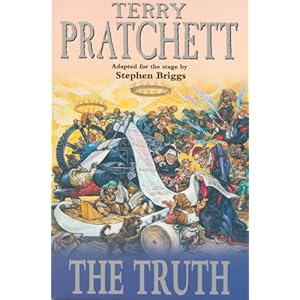Before I got caught up in the massive project that was the Hugo Award Winners: Novels lens that I published Sunday evening, I had another big project: Discworld.
Terry Pratchett's Discworld series, which started in 1983 and really got rolling a few years later, is one of those series I was aware of, but I just didn't think I was a big fan of fantasy. On the other hand, I kept reading about him being compared to Douglas Adams, the Hitchhiker's Guide to the Galaxy guy, and I'm a big fan of Adams.
But I'm not a really big fan of fantasy, or at least I wasn't. To me it just seemed like too much of it was sword and sorcery and all of it was taken much to seriously. It turns out that's pretty much the feeling Terry Pratchett had in mind when he started the Discworld books. He basically looked at the genre and stood it on its head.
Pratchett's got a madcap sense of humour at least as far out as Adams had. His main wizard character, Rincewind, isn't very good at wizarding, although he does have this way of surviving. Unseen University, the place wizards go to learn their trade and often remain, is peopled by a faculty and staff that's gotten very complacent and fat, enjoying six hearty meals a day and not doing much magic at all unless it's something involving plots against wizards higher up in the hierarchy, and the results of the plotting can be fatal to the plottee. The university is in Discworld's largest city, Ankh-Morpork, a sprawling disorganized mess of a place where, Pratchett says, all roads lead from Ankh-Morpork, not to it. It's just that some people, those headed to the city, are going the wrong way.
There are witches, including grim Granny Weatherwax, jolly Nanny Ogg, and young Magrat Garlick, who is pretty much a parody of modern-day New Age influenced practitioners of the occult.
There's Death. Death SPEAKS IN ALL CAPITAL LETTERS and rides a pale white horse. The horse's name is Binky.
Everyone lives on a flat round and highly improbable world that's carried on the backs of four huge elephants who, in turn, stand on the back of The Great A'Tuin, a 10,000-mile long turtle swimming through space. Since the world is flat, if a ship at sea disappears from view like it's falling off the edge (as people on Earth used to think), it's because it's falling off the edge. Water from the ocean cascades off the edge, yet Discworld and it's oceans never run dry.
It all sounds wildly fantastic, and it is, but Pratchett has a way of telling great and very funny stories about the world and the characters in it. There are plenty of references to fairy tales, Shakespeare, movies and other bits of culture from our world to make Discworld seem sort of familiar in its weirdness.
There are currently 38 books in the Discworld series, with several major categories. Someone had previously done a Discworld lens about why they shouldn't be read in order. I decided to make a lens listing them all in order starting with The Colour of Magic, which some say isn't the best place to start. Pratchett has said it wasn't until several books in that he discovered this wonderful thing called "plot." But I started reading that book and, being used to Hitchhiker's Guide to the Galaxy, didn't have any problems with it. I just continued on with The Light Fantastic and kept going. I'm currently between the 12th and 13th books, taking a break to read other things.
The lenses I made are:
Discworld Novels 1 to 10
Discworld Novels 11 to 20
Discworld Novels 21 to 30
Discworld Novels 31 to 40
31 to 40? Well, yes. While there are only 38 published books, plans are in the works for at least two more. If I'd named the fourth lens Discworld Novels 31 to 38, I'd have a problem when the next books came out. This way no renaming is necessary and if Pratchett goes on past 40 I can put those books in a new lens.
There's a fifth lens for Discworld books related to, but not part of the series:
Discworld: Related Books
This lens links to the mapps, the Science of Discworld books, art, folklore, a companion, and even a children's book that grew out of the City Watch commander's reading to his young son.
Not having read past the 12th book, I had to rely pretty much on plot synopses I could find online. Some were way too brief, others were way too wordy, with some of the latter being the length of short stories. I just wanted something short, but enough to generate interest. Using a graphic online Guide to Discworld, I color coded the borders and backgrounds of each book description to relate to the categories defined by the guide: Rincewind, Witches, Death, The City Watch, etc.
I'm having a lot of fun reading the series. I just wish I hadn't waited so long to start reading it.



No comments:
Post a Comment